|
|
|||
| Product Design | My Artwork | Living Sustainably | |
| Art Engineering | Wood bowl turning class | Solar Power | Chevy Volt |
| Solar Heating | Thermal Windows | ||
| Contact | About Me | Solar Hot Water | Solar Mower |
|
|
|||
| Product Design | My Artwork | Living Sustainably | |
| Art Engineering | Wood bowl turning class | Solar Power | Chevy Volt |
| Solar Heating | Thermal Windows | ||
| Contact | About Me | Solar Hot Water | Solar Mower |
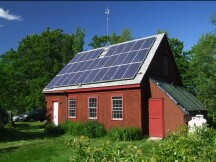  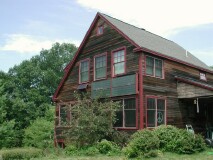 | |
|
I am deeply concerned about climate change and the devastating effects that will affect our lives in the near future and dramatically affect the entire world for generations. I believe in doing my best to reduce my use of fossil fuels and live sustainably. I work at encouraging people to reduce their energy consumption, live more simply and adopt renewable energy, both by example and through the press, my web site and blog. I also do building energy audits in midcoast Maine with the Midcoast Green Collaborative. It may seem like I have a lot of disposable income to invest in all this stuff, but keep in mind that what you see on this page took many years. I am self employed with no kids and have a moderate income - I just choose to invest in things that leave the world a better place. Most of the things I have invested in have already paid for themselves - such as the solar heating systems. Below you can learn more about all the many measures I and I have taken to live lightly on the planet. Hopefully I will inspire you to take some steps - Guy |
|
 If you are looking for a book to guide you through the process of improving the energy efficiency of your home and everything within it, then I can highly recommend Charlie Wing's book: "The Visual Handbook of Energy Conservation: A Comprehensive Guide to Reducing Energy Use at Home". This is the most complete guide imaginable and an excellent resource for anyone planning to build a new home or reduce the energy use within an existing home. As someone who has direct experience with a great many of the ideas and suggestions within the book I can say that it is an ideal resource and there is no question that you will learn a great deal of valuable and useful information. |
|
My blog: |
|
| VEHICLES | |
 2017 Chevy Volt  2021 Chevy Bolt |
In May 2012 I purchased a new Chevy Volt electric vehicle Learn more about the Volt on
this page of my site.
In 2015 I drove about 8000 miles and purchased only 40 gallons of gas.
Yes, that's 200MPG! In February 2024 I moved up to a 2021 Chevy Bolt all electric vehicle. Range of over 200 miles. |
 tire pressure gage |
TIRE INFLATION If your vehicle does not come equipped with tire pressure monitoring you can install these simple devices. If the air pressure in your tires tires are low it can cost you as much as 3% of your gas mileage. I highly recommend these neat little gauges that screw onto the valve stem. They have a window that that shows green if the pressure is good and red if it's low. A set of 4 retails for about $23. Click on the image to order them from a US manufacturer - not a cheap import, these are very well made. |
| LIGHTING | |
 |
LED UNDER COUNTER KITCHEN LIGHTS I light my kitchen with 4 - 13 Watt LED flood lights, but if I just need to use the counter top I have installed LED light strips on motion sensors. They come on automatically and use about 2 Watts, compared to the typical fixture that would have 3 or more 12 to 35 Watt halogen lamps. Most of the time, I never bother turning on the ceiling lights. |
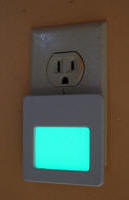 |
I use inexpensive LED night lights throughout the house, they use pennies worth of electricity per year. By comparison a typical 7 Watt night light left on all day wastes 168 Watt-hours/day- that's over 5kWh per month! More info on LED vs electroluminescent night lights on my blog. Click the image to buy some online. |
 outlet strip
|
PHANTOM LOADS Stereos and any device with remote control - like VCRs and DVD players all stay on all day waiting for the remote signal, this is called a "phantom load". That can add up to a lot of power. Any electronic device that uses a wall adapter (engineers call them "wall warts") is a potential phantom load that can be switched off with an outlet strip or un plugged when the device is not in use. A simple rule of thumb - if it feels warm it is using energy, so unplug cell phone chargers etc when you are not using them. Of course cordless phones and answering machines must remain on. But DVRs can be controlled with a timer - see below. |
| SAVING ELECTRICITY | |
 Kill-a-Watt Meter 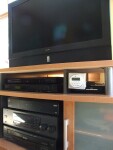 Timer (white unit) controls TV + stereo |
MEASURING ELECTRIC LOADS A Kill-a-Watt Meter is a simple device that sells for about $30. You plug your appliance into it and it displays, Watts, Amps, Volts and Watt hours amongst other things. Leave your appliance plugged in for a day to see how many Wh it consumes! It will record how many hours it measured. I use a timer (see below) to turn on my TV and sound bar just when I use it which is from 6:00pm to 12:00pm. This saves me about 8 kWh each month. Here in Maine we pay around 15 cents/kWh for electric power and the timer saves me $1.20 per month while reducing fossil fuel sourced electric power from the utility. Maine participates in the Regional Greenhouse Gas Initiative (RGGI) that mandates that a carbon cap on all electric utility power. Currently over 50% is sourced from renewable generation - mostly from hydro power, but also from wind and biomass generators. |
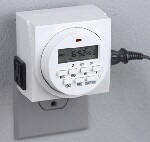 |
I use timers that to reduce phantom loads to save power (see above). One in the house turns my light sculptures and decorative on only in the evening. I use another to control the heat recovery ventilator in my home office in my very well sealed workshop so it only runs during my office hours in the winter. The timer that I found uses less than 1 Watt (compared to over 3 Watts for the old noisy mechanical rotary timers) and has a battery backup so it never loses time in a power outage. It can be set for multiple times/day and only on certain days of the week, it is available for abount $12.00. A nice feature is the button at bottom right that allows manual override ON/AUTO/OFF/AUTO. This makes it simple to turn on the load with 2 button presses and then leave it in AUTO mode to shut down at the next programmed interval. Click here to buy one. |
 sensor switch |
SAVING POWER WITH A ROOM OCCUPANCY SENSOR SWITCH When I walk into my workshop, I walk through the ground floor to get to my 2nd floor office. The light switch is by the front door, and I used to end up leaving it on for hours so that I could see to get back out. This really bugged me, so I installed a Room Occupancy Sensor Switch in place of the wall switch for about $15.00. It senses motion in the room from up to 30 feet away and turns on the light for several minutes - and remains on if it sees a moving person. I can adjust the sensitivity to motion, the time delay, and the room darkness before it will switch on. It is shown at left with the programming cover removed. I can press the bottom panel to manually override the switch on or off which I do when leaving the building at night. |
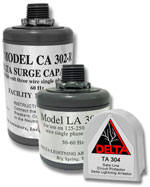 |
PROTECTING ELECTRONICS If lightning hits your home or power lines you could lose all your electronic equipment. Think of what that would cost to replace, and the potential data loss from computers! Not to mention the potential loss of your entire home due to fire. I installed a lightning arrestor and 2 other devices from Delta Surge Protectors, 2 in the circuit breaker box and one in the telephone interface box. In spring 2007 we had a massive lightning storm and 2 strikes right on the power line that damaged the pole transformer for the house. The surge protectors saved all my equipment except the cable modem - the surge came in the cable wiring. This is the best insurance you can buy for your equipment. I later installed a lightning protection system on both buildings since the house is on a rise and has had several near misses over the last 8 years. |
 solar yard light  motion sensor flood light |
The path from the house to my workshop is over 70 feet, on a moonless night it is totally dark out here in the country, so I installed several motion sensing solar powered lights to light my way. These inexpensive lights use a solar panel to charge a battery inside in the daytime, then turn on when they see movement nearby. More info on my blog. I particularly like these warm light units - most are cold white which is not as "friendly". To light the parking area so that I can see to unload vehicles I installed a motion sensor flood light with LED flood lights that turns on for only 5 minutes at a time. This saves more energy than one that turns on at dusk and stays on all night. |
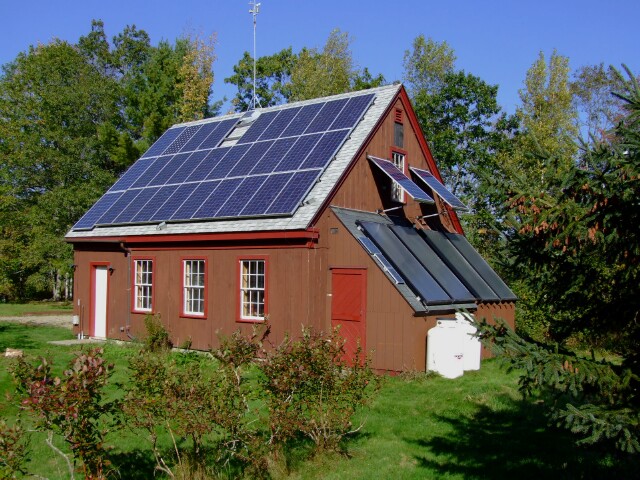 |
In August 2009 I
installed a 4kW solar electric array (23 175-Watt panels) on the west
facing roof of my workshop with the help of friends and neighbors.
My detailed installation blog
shows the whole process from financing to completion. |
 |
ENERGY STAR APPLIANCES My major and smaller appliances all have good Energy Star ratings for efficiency. For instance my 2000 model refrigerator which has a freezer on the bottom with a separate door consumes an average of 225 Watts when running - which is about 40% of the time for a total of about 64kWh/month (2.1kWh/day). Refrigerators are one of the biggest electrical energy users in the home and replacing old ones can have a dramatic impact on reducing your electric bill. A tip for reducing energy in refrigerators is to fill any unused space with water jugs (in old milk bottles). This increases the thermal mass/storage inside the refrigerator. |
 dishwasher set for Eco mode |
USING ENERGY SAVER OPTIONS My dishwasher has energy saving features that allow me to set it for Air Dry which does not use the 500 Watt heater. I also use the Eco setting most of the time to reduce energy as it is a shorter cycle that also uses less water. I use the delayed start feature to start the wash cycle in the afternoon - after the sun has heated the water in the solar storage tank on sunny days. Incidentally using a fully loaded dishwasher uses considerably less water than washing them by hand, so I use it for most of my dish washing needs. |
 water heater |
LOWERED HOT WATER TEMPERATURE Like most water heaters, the old tank heater came set at a default of around 130F which can scald you in 30 seconds. I set my tankless water heater (installed 2010) to 120F to reduce propane consumption. If you find that you always add cold water when washing or showering, then you can turn down the thermostat on your water heater to the point where you no longer add cold water. This will save all the energy that goes to waste - heating water above the temperature that you actually use. |
 |
INSULATING THE WATER HEATER I wrapped the solar storage tank (a 40 gallon electric water heater that is not wired) with fiberglass a blanket. This simple inexpensive action will reduce heat losses by 25% - 45%. This will save around 4% - 9% in water heating costs on a regular tank style heater. Blankets are available at most hardware stores for about $10.00. Note that they often sell a top piece separately from the side-wrap. |
| SAVING WATER | |
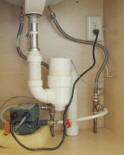 pump under sink |
CONSERVING HOT WATER Like many houses, the main bathroom is on the 2nd floor at the far end of the house from the water heater. A total of about 45 feet of copper pipe that must be heated before hot water arrives at the faucet. This takes over a minute - or longer in colder weather. This wastes a lot of water (and well pump energy) as I used to run the shower and wait for it to warm up! I installed a pump made by ACT, Inc. Metlund Systems, for around $330. This unit conserves water by using a 57 W pump to draw hot water up to the faucet at the press of a button - and re-circulating it back to the water heater, it shuts off once the water is hot enough, typically in less than a minute. Click the image to learn more. |
 |
The Story of Bottled Water, employs the Story of Stuff style to tell the story of manufactured demand — how you get Americans to buy more than half a billion bottles of water every week when it already flows from the tap for free. Over seven minutes, the film explores the bottled water industry’s attacks on tap water and its use of seductive, environmental-themed advertising to cover up the mountains of plastic waste it produces. The film concludes with a call to ‘take back the tap,’ not only by making a personal commitment to avoid bottled water, but by supporting investments in clean, available tap water for all. |
 |
DRINKING WATER My water comes from a well and I run it through a PUR faucet filter on my kitchen faucet to remove the metallic taste of the copper plumbing in the house. I do not drink bottled water (see above). |
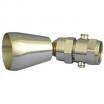 low flow shower head |
LOW FLOW SHOWER HEAD I installed a low flow shower head that I measured at 1.6 Gallons per minute yet it has good pressure and an invigorating spray. For reference a few years ago average showerheads delivered about 5 to 8 gallons per minute (gpm) at 80 psi (normal city water pressure). The current standard for low-flow heads is 2.5 gpm at 80 psi. The pressure from my well pump is a nominal 45psi which aids in reducing flow. A 10 minute shower uses about 16 gallons vs 50 gallons at 5 gpm, or 25 gallons at 2.5 gpm. Here is some interesting info about low flow shower heads. I could think of my well water as "free" until I consider the 1600 Watts that my well pump uses. |
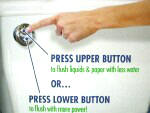 |
I installed Hydroright dual flush adapter kits from ACE Hardware in both toilets. At about $25 they are affordable and simple to install, it took me about 20 minutes. A round fixture replaces the handle, it has 2 buttons - the top one is low flush and the bottom larger button provides a full 1.6 gallon flush. This can save thousands of gallons a year, and reduce the power needed to operate the 1600 Watt well pump. (Update: my hard water produces calcium deposits that ruin these unit in a year or so) |
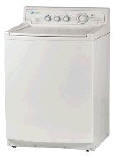 Staber washer |
EFFICIENT CLOTHES WASHER I purchased an ultra efficient American made washing machine in 2001. Staber washers use 67% less water, 50% less energy, and 75% less detergent compared to traditional top load agitator washers made at the time. It is the only top load horizontal-axis washer made in the U.S. There are also many design advantages compared to front load washers. It is super reliable, my first repair after 13 years took only 1/2 hour and was easy because the front is removable to gain access to the entire mechanism. While these units are pricey at around $1300, the energy savings pays for it rather quickly. It saves electricity on the well pump which is a significant energy user (240 Volt, 1600 Watt), not to mention propane used for water heating and electricity costs to operate the washer. It can be rough on delicates though. (Still going strong in 2024!) |
 50 gallon rain barrel |
RAIN BARRELS I have 2 - 50 gallon rain barrels that I use in the warmer months that captures water from the house roof, they have hose spigots on the bottom. I use the water on the vegetable beds to reduce the load on the well pump. More info about how I made mine on my blog. A company in Maryland called Aquabarrel sells barrels and kits for conversions along with downspout adapters etc. |
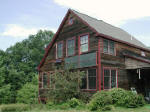 solar collectors on wall |
SOLAR WATER HEATING In July 2006 I purchased and installed a complete solar kit that augments the propane domestic hot water heater. The solar collectors mounted on the south wall of the house pipe heat into a 40 gallon storage tank when the sun is shining. This tank feeds into the propane water heater which now runs much less often. Solar water heaters are one of the simplest, and least expensive ways to reduce energy in your home with an average installed cost of $4-8000. The design goal is to reduce the energy required to heat water by 75% per year, with a 90% savings in the summer. See real-time performance stats here. My system cost me $3200 but my net cost after Maine State's 25% refund and the 30% Federal tax incentive was $1440 (not including installation which I did with friends and neighbors). To learn more about solar incentives visit the DSIRE web site for state by state listings. The calculated break-even on the net $1440 cost was around 4.5 years. To find a
solar installing contractor in your area,
click here. |
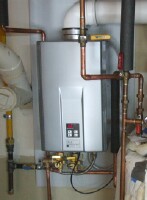 |
In June 2010 the propane fired water heater tank blew a leak, so I replaced it with a Rinnai R75LSi tankless propane unit. This reduces the standby heat loss from the tank and operates more efficiently since propane is only used when hot water is needed. I can set it in 5°F increments and usually leave it at 120°F, occasionally raising it to 125°F as needed. Most standard water heaters come set at around 130°F which is dangerously hot and can scald you within 30 seconds. Suggestion: try locating the thermostat setting on your water heater and turning it down a tiny amount every day until you or someone in your household notices the water is not warm enough. At this point you can turn it back up another notch. You will probably find that when taking a shower you no longer need to mix cold water in and will save a substantial amount of energy. |
| ENERGY MONITORING | |
  |
I have installed energy monitoring equipment with
live web interfaces to make my renewable energy sources transparent: ●Solar electric power generated vs utility power consumed ●Solar domestic water heater ●Heat recovery ventilation system temperatures |
| HEATING AND COOLING | |
.jpg) |
In December 2008 I conducted a detailed
infrared thermal study of the outside of both both buildings, see the
images and my observations here.
Most
home energy auditors will use a thermal imaging camera inside your
home to evaluate exterior insulation.
|
 |
INSULATING EXPOSED FROST WALLS The frost walls of my workshop are exposed above ground by up to 24" in places. So I covered them with 2" of blue foam board and exterior sheathing. This reduces the heat loss dramatically along the base of the interior walls. Where practical, I also added 2 inches of foam horizontally coming out from the wall up to 2 feet. This is sloped away from the building so that it drains correctly. For every foot out from the wall you gain the equivalent insulation a foot down below grade. |
 |
To improve the insulation of the exposed concrete walls of the daylight basement in the house, I added 4" of rigid foam insulation to the outside. This adds about R24 to the wall and should prevent it from remaining below freezing for much of the winter. It's a simple and relatively inexpensive process to add rigid foam to any exterior wall and the benefits can be significant in cold climates. Click the image to learn more. |
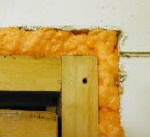 |
INSULATING DOOR AND WINDOW FRAMING During the energy audit of my home in November 2008 I found several doors and windows with air leaks from around the framing. Here I show how I removed the trim and found huge gaps that required filling with spray in foam. Click the image to learn more. After sealing up these gaps, I noticed that the humidity level in the house was higher in the winter and no longer needed a humidifier in the bedroom to maintain comfortable humidity. |
 spray in foam insulation   |
BUILDING INSULATION When I converted my open barn to a heated work space, the first thing I did was to contract the installation of spray in isocyanurate foam (Corbond) that completely seals the building with high R value insulation (R7.5/inch). My workshop is considered "super insulated" with R30 walls and R45 roof, and it is very well sealed around doors and windows. For new construction I recommend spraying in 1 to 2" of foam and then adding fiberglass over that. This yields the best performance characteristics of both types for the best price per dollar in my opinion. Another popular choice is blown in dense pack cellulose. The single best way to reduce your heating and cooling energy costs is to insulate your building envelope well. Most buildings are poorly insulated and have many air leaks that allow heat to escape. Simply identifying and sealing the cracks around doors and windows can dramatically reduce your heating costs -- see above. |
 |
A SOLAR ATTIC VENT HELPS COOL MY OFFICE This simple, elegant vent only works when the sun is shining and heating up the attic above the office in my workshop. It has reduced the attic temperature in my workshop by 20°F to 30°F and I have noticed it does not get as hot in my second story office in the middle of the summer. |
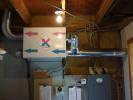 HRV unit |
A HEAT RECOVERY VENTILATION SYSTEM The drawback of having a very well sealed building envelope is that indoor air quality can suffer. One needs to exchange all the air in a building about every 3 hours for optimum health. While this is easy in the summer as the windows can be opened, it is not sensible to leave them open in the winter! An HRV system uses blowers to exchange the air in the building while recovering most of the heat that leaves the building and using it to heat the incoming air. The unit I installed is relatively inexpensive and is over 84% efficient. The air in the building feels fresh all day and I just feel better and more energized at work. Click the image to learn more. |
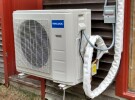 Mr Cool heat pump |
In March 2021 I installed a DIY
heat pump made by Mr Cool. I saved thousands of dollars by
installing it myself and this will replace the propane heater used to
heat my house. |
 ERV vent |
A SINGLE ROOM ENERGY RECOVERY VENT My well constructed home was built in 2000, and over the years I have succeeded in tightening it up to the point that the air inside is not being replaced sufficiently for good health and when I seal up the windows in the winter I found that kitchen smells lingered for many hours. Clearly, I needed more fresh air! I decided to install a single room Energy Recovery Ventilator called the TwinFresh Comfo. It installs in a 6 inch diameter hole in an exterior wall and consumes just over 5 Watts. It is over 90% efficient at bringing fresh warm air into the home during the winter. |
 |
ADDING ANOTHER ENERGY INEXPENSIVE RECOVERY VENT My small second-story bedroom has two windows, but I close one off in the summer for the air conditioner and also close them tightly in the winter so I don't get much fresh air in there. Having installed the unit above, which cost about $500, I decided to look for something less expensive and found one on AliExpress for around $250. It's a direct clone of the TwinFresh Comfo with some minor improvements. |
 digital thermostat |
PROGRAMMABLE THERMOSTATS I have replaced all my thermostats with Google Nest thermostats. These amazing devices are fully programmable, compatible with all voice assistants, and accessible from a phone app anywhere. They encourage conservation by rewarding you with a green leaf when you set back your heating system in the winter or raise your set point in the summer. Learn more about this in my blog post. For my bedroom, I built an interface to control a small 1200 W electric heater. See this blog post for details. |
|
wood stove |
HEATING WITH CLEAN BURNING WOOD STOVES The basement is heated with a wood stove that is large enough to heat the whole house, and I also supplement the solar/propane heating in my workshop with a stove that I added in 2005. I use both stoves extensively in the winter to reduce my use of propane. Replacing an old wood stove or fireplace with a more energy efficient appliance can save fuel, money and protect you and your family’s health. Older stoves that were manufactured before 1990 burn wood inefficiently which wastes firewood, pollutes the air in your neighborhood and creates dust inside your home. Newer stoves can reduce smoke and dust, as well as cut heating expenses. The Regency F3100 stove is 77% efficient for instance. I also improved the effectiveness of my workshop stove with a heat reclaimer. |
|
|
FIREWOOD I fell trees on the 2.5 acre wooded property that I cut with an electric chain saw. I split the wood by hand, and stack it to season for 6-9 months before burning. Heating with wood is carbon neutral and renewable, so long as responsible forestry management practices are used. I begin each year by looking for standing dead trees or blow-downs. |
 my handmade wood bowls |
TREES TO BOWLS I also make wood bowls from locally felled trees. Sometimes neighbors bring me chunks, or I find a downed apple or cherry tree that I can salvage. More info on my blog. Like the Native Americans, I try to make full use of my local resources. I use the shavings for kindling, garden mulch and cat litter. |
 |
ELECTRIC CHAIN SAW I use a Oregon CS1400 15 Amp Electric Chainsaw on a 100ft 10 gauge cord. It's just as powerful as gas ones without the smelly gasoline, noise or pollution! I have felled 50ft trees that were over 20" at the base with this saw. It is essentially solar powered since it runs off my solar power system during daylight hours. |
 |
CORDLESS ELECTRIC CHAIN SAW To fell trees from the back woods, I use an Oregon PowerNow 16-Inch lithium powered cordless chain saw. This is a very powerful saw that can cut down trees like a regular gas saw. I fell hardwood trees up to 12" diameter at the base and cut them into portable length logs that I carry to my cutting/splitting station where I buck them into shorter lengths with my corded electric saw (above). Many other cordless chainsaws are now available. I would consider EGO or GreenWorks brands. |
 Marvin Window AEP insulating panel |
Windows are the single largest source of heat loss in most homes. The folks that built my house in 2000 installed very good Marvin windows. These units are wood framed with tightly sealed vinyl sliders and they have dual pane low E glass filled with inert gas. With all these features they have a very high R value (about R-3) and low air leakage. My workshop came with very inexpensive wood windows that were loose fitting and drafty. In the winter I seal them from the inside using home made interior storm windows. These double glazed plastic panels fit into the inside of the window frame like a window screen and form an airtight barrier that seals the window with double pane plastic. |
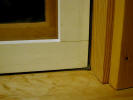 window panel detail |
MAKE YOUR OWN
INEXPENSIVE In 2008 my friend Topher designed and easy to make interior storm window. The cost of materials is under $1.30/sq.ft. compared to over $9.00/sq.ft. for commercially made ones. Click here for detailed instructions on making these yourself. |
 |
Every Fall I take down all the window screens on the house and workshop when I install the window panels above. This gives me an estimated 30% gain in sunlight through the sun-facing windows which can really contribute some heat during the winter. I put them up when I start to see bugs in the spring. |
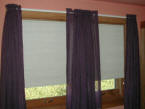 |
The house was designed to be somewhat passive solar with many south and east/west facing windows in the master bedroom and 1st floor living/dining area. Even though the house has high quality double pane, gas filled, low-E, wood framed windows with sealed vinyl sliders the R value is still only around 3.
|
 vegetable beds |
HOME GROWN FOOD I have 4 raised vegetable beds that I seed with various veggies including onions and garlic and a variety of herbs such as basil and chives. I actively maintain and prune the 4 high bush blueberry bushes that produce a bountiful crop. Some years I have made over 30 jars of jam! My crabapple tree produces 30+ lbs of fruit from which I can make dozens of jars of crabapple butter per year. I also purchase locally grown and organically produced foods from local farmers at the farmers market and local natural food stores.. |
| RECYCLING | |
 |
RECYCLING Our small rural town
(pop. 3000+) started curb side pickup of mixed stream recycling in 2010.
This includes cardboard, paper, newspaper, clear glass, plastic (5
types), tin and aluminum. Our town now recycles more than 40% of
our waste stream. Our recycling is processed by
ecomaine where
non-hazardous waste goes to a Waste-to-Energy Facility, where it
generates enough electricity for their buildings, electric car, and
about 15,000 homes in Maine! |
|
In January 2015, I decided to weigh my trash and
recycling bins and record the net weight. Recycling is picked
up bi-weekly. For reference the EPA says an average American: "...recycled
and composted 1.51 pounds of our individual waste generation of 4.38
pounds per person per day." Last years chart can be seen here. I recycled 58.34% of 1009 lbs of waste. |
 |
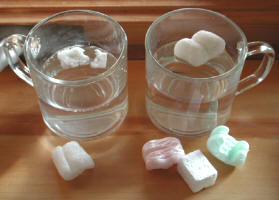 |
PACKING PEANUTS There are 2 types of peanuts currently in use: starch based and Styrofoam. The starch peanuts dissolve in water and can be disposed in the trash or compost. A quick test, touch one to your tongue, if it sticks - it's starch, if not it's styrofoam. Or drop one in a glass or water to see if it dissolves. I re-use the Styrofoam peanuts to ship my products, or take them to my local packing/shipping store, here is a map of drop-off locations. Most packing stores welcome your contributions. You can also drop off Styrofoam at a number of recycling locations throughout the US, here is a map. |
|
compost jar |
COMPOST I keep a compost container on the kitchen counter. All my vegetable scrap goes in this which has a lid with a carbon filter in the lid to reduce the smell. Of course I try to empty it before the point where the contents start to rot! Note, if you get fruit flies in your kitchen from your compost bin, a good way to eliminate them is to put out a shallow bowl with apple vinegar in it and a drop or 2 of dish washing liquid. The flies are attracted to the vinegar because it smells like rotting fruit and the detergent reduces the surface tension so they drown. I dump the contents into my rotating composter which sits at the corner of the front porch. This is the best unit I have found since it is so easy to use, just turn it over 3 times every so often to mix the contents. There is no smell, and the roller base collects the compost "tea" which when diluted makes excellent fertilizer. The compost itself gets dug in to the flower and vegetable beds. More info on my blog. |
 |
The
Story of Electronics, takes on the electronics industry’s “design
for the dump” mentality and champions product take back to spur
companies to make less toxic, more easily recyclable and longer lasting
products. The eight-minute film explains ‘planned
obsolescence’—products designed to be replaced as quickly as
possible—and its often hidden consequences for tech workers, the
environment and us. You can locate an e-waste processing center through eStewards.org a site dedicated to responsible recycling of e-waste. I drop off my old dead electronics at Best Buy. |
|
drying zip lock baggies |
RE-USING ZIP LOCK BAGGIES By simply rinsing them out I re-use baggies many times over before they wear out! I also use HoldOn compostable trash and zip lock bags. |
 rechargeable batteries  |
BATTERY RECYCLING I recycle all rechargeable batteries by taking them to local drop off sites which are located in retail stores nationwide (including Lowe's hardware stores) that are organized by the Rechargeable Battery Recycling Corporation (RBRC) . Click here to find your nearest drop off site. I have recycled batteries from laptops, emergency lights, cameras, power tools, cell phones etc. Rechargeable batteries contain toxic cadmium, lithium, lead, acid and other chemicals that don't belong in our landfills. Did you know that automobile lead/acid batteries have been recycled since the beginning of the auto industry? They are one of the most recycled products in the world! |
 |
PRINTERS and OLD MOBILE PHONES Decluttr is the fast, easy and totally free way to sell cell phones, tech, CDs, DVDs, games and books. Simply get an instant valuation, ship for FREE and get paid! - I sold my old Moto G7 for $24, and it only took a few minutes. |
 printer cartridge |
PRINTER CARTRIDGE RECYCLING Staples stores offer a credit to their Rewards customers for cartridges and I turn all my old ones in. There are many other ways to recycle these expensive items. |
 |
OLD PAINT There are now some options for recycling old house paint. I have taken many partly filled old cans to my local hardware store that participates in the paintcare program - click the link to find a drop-off location near you. More info on my blog. |
| REDUCING WASTE | |
 |
The Story of Stuff is a 20-minute, fast-paced, fact-filled look at
the underside of our production and consumption patterns.
The Story of Stuff exposes the connections between a huge number of
environmental and social issues, and calls us together to create a more
sustainable and just world. It'll teach you something, it'll make you
laugh, and it just may change the way you look at all the stuff in your
life forever. Click image to view movie. |
 |
I made a rubber stamp that says "please remove from your mailing list - thanks". When I get any junk mail that has a prepaid return envelope and a return order/contribution form, I stamp the form and return it in the envelope provided. Eventually they get the message. You can also sign up with the National Do Not Mail List, it's free and easy to get yourself removed from catalog mailings. This only works with direct mail advertizing, the rubber stamp will work with non-profit and political mail. |
 |
PAPER OR PLASTIC? . . . NEITHER! Both types of bag have trade-offs that are unacceptable. I use cloth bags to carry groceries, and re-cycle the plastic and paper bags from other stores. Whenever practical I decline the use of a shopping bag and use y own or just carry it to my car. |
 |
FIX IT - DON'T TOSS IT When something breaks my first impulse as a "well trained American consumer" is to toss it an buy a new one. But I have a broad range of skills that I can apply to repairing everything from furniture to electronics. Case in point: my 37" flat screen LCD TV stopped working, the HD input failed. I opened it up and identified the motherboard. By looking up the make and model on-line I found a supplier of surplus replacement parts. At a cost of a little over $100 I found a replacement board. It took about an hour to replace using nothing more than a screwdriver, ingenuity and patience. |
 septic pumping |
SEPTIC TANK Every 3-4 years I have my 1000 gallon septic tank pumped out. The company that provides this service, Pat Jackson Inc., They have a processing facility that recycles some of the waste into fertilizer. This particular form of recycling came as a surprise to me too! Yes, I know, you're thinking: "This guy even recycle his own shit"! |
|
If you found the information presented on my web site to be helpful you can send
me a donation to show your appreciation for the many hours I have invested in
presenting my knowledge and experience. This is NOT tax deductible and will
show as a consulting fee on your receipt. |
|
|
|
|
|
If you are not part of the solution, then you are
part of the problem. |